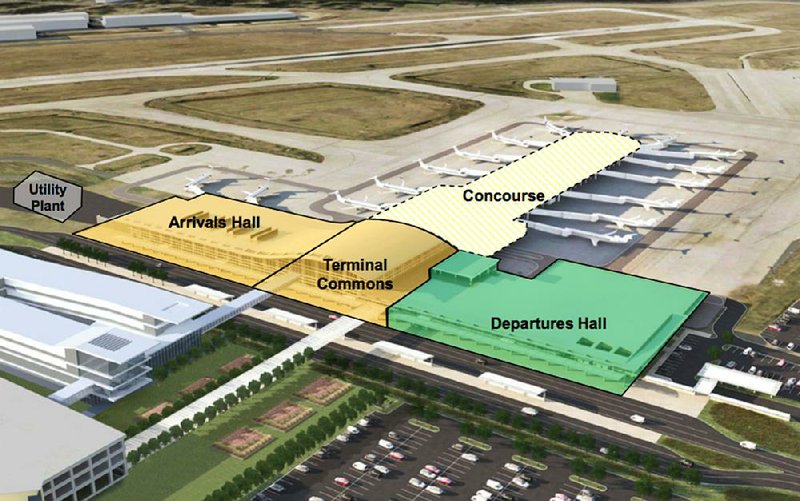A reconfigured passenger terminal at Bill and Hillary Clinton National Airport/Adams Field that includes an arrival hall is the centerpiece of $450 million in capital improvements that officials at the state's largest airport envision building over the next 20 years.
The arrival hall, construction of which wouldn't begin until 2027 or 2028, would include space for a federal inspection station, and two additional gates to accommodate U.S. Customs and Border Protection and international passenger arrival services.
The new design for Little Rock's airport also envisions reworking the roads to the facility to eliminate the winding route around the terminal and replace them with a straight avenue that passes by both -- called the ticket lobby and the new arrival hall.
The arrival hall would replace the baggage claim area, which is in the way of the planned roadway.
Many of the capital projects would replace aging facilities, airport officials say. They anticipate an increase in passenger boardings, which are expected to climb 1.4 percent annually to more than 1.3 million by 2036.
A briefing about the master plan, which remains a work in progress, was held Tuesday, the same day the airport's executive director, Ron Mathieu, said the airport was shifting $6.5 million in unrestricted cash into a restricted category devoted to building a cash reserve to help pay for the arrival hall.
The category now contains more than $18.8 million, which is but a down payment on the airport's daunting $166 million share of the $450 million overall cost.
"We have $52 million in the bank and $18.8 million for the terminal," Mathieu said. "We need $166 million."
Stacy Hurst, the chairman of the Little Rock Municipal Airport Commission, expressed a worry that the master plan will bind future airport commissions.
But consultants helping the airport develop the master plan say the document will be flexible.
"It is the best outlook for a good plan for the future that we can use as a map ... but it's also very flexible with the timing," said David Neyer, a principal consultant for Cincinnati-based Leigh/Fisher. "It lays out a concept. It will probably be looked at in another master plan in the next seven to eight years."
The airport's previous master plan showed flexibility. Its forecast for passenger boardings in 2018 was 1.3 million, the same number the new master plan says won't happen until 2036. It contemplated the airport expanding its concourse, which has 12 gates, beginning in 2020.
That plan resulted in a $67 million revamp of the airport terminal, which originally opened in 1972, and a $25 million upgrade of the concourse.
The master plan now under development doesn't anticipate needing to expand the concourse. Even the federal inspection station and its two gates could be left as an unfinished second-floor shell to save money on developing the arrival hall.
"The terminal can perform at a high level of service with 12 to 14 parking gates," the consultants said in briefing documents.
The airport's passenger numbers jumped markedly in April, when 173,025 passengers passed through, a 6.72 percent increase over April 2017, according to T.J. Williams, the airport's air service development director.
Passenger traffic showed a 1.25 percent increase in the first four months of this year, to 613,363, compared with the same period a year ago.
April's increase coincided with the addition of direct flights to and from Washington, D.C., by American Airlines; to and from Denver by Frontier Airlines; and to and from Austin, Texas, by Via Airlines.
"It is a significant one-month increase," Mathieu said. "We are excited about that, and we would like to see it continue."
Last year, passenger traffic edged up 1.9 percent, to 2,029,309, the first time in three years that more than 2 million passengers went through Clinton National.
Though the proposed master plan doesn't contemplate building the arrival hall for another decade, other work costing millions of dollars will be needed to prepare the airport for its construction.
Relocation of the central utility plant alone will cost $34 million. It will cost several million dollars more to move underground drainage structures and relocate the airport fuel farm. The eventual construction of the arrival hall will cost an estimated $217 million.
The plan also envisions creating new parking areas in front of the arrival center and east of Airport Drive to help replace parking displaced by the construction of the arrival hall and other projects.
Among the projects considered but ultimately discarded for now as unneeded in the next 20 years was a new parking deck between the arrival hall and the existing parking deck.
While the proposed master plan includes flexibility on some projects, such as the arrival hall, and whether the airport actually builds it in the time frame outlined, the Federal Aviation Administration is more firm on expected changes totaling $65 million to the airport's network of taxiways, said Tom Clarke, the properties, planning and development director for Clinton National.
The changes center on Taxiway C, which runs along Runway 4L-22R separating the runway from the Dassault Falcon Jet aircraft completion complex.
A new taxiway would be built to help eliminate short, high-speed taxiways that aircraft can use once they land, as well as remove a five-way taxiway intersection.
Removing Taxiway C would open 20 acres that Dassault Falcon could use to build a new hangar to paint aircraft, officials said.
Hurst pressed for the commission to sign off on the final master plan document before it is submitted to the FAA. She said she is impressed with the work so far.
"I certainly appreciate the effort that goes into this," she said. "It's substantial. And I think it is a significant plan. Well done. Ambitious.
"I like the fact that it is fluid, and I appreciate the staff's comment that we want to proceed with caution and make sure it's justified before we go to the expense."
Metro on 05/16/2018
